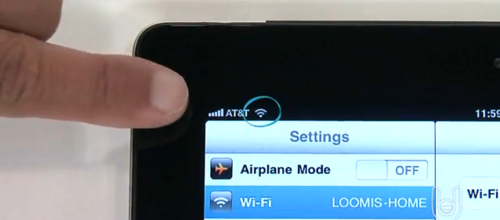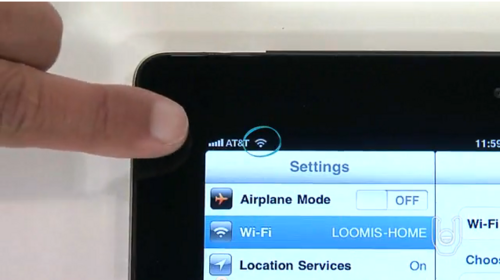Srinivasan’s Curious Question
One the more puzzling parts of the oral arguments in the challenge to the FCC’s most recent Internet Service Provider regulations was Judge Srinivasan’s iPad question. It was a singular moment in the proceeding, one that has prompted commentary from from the pro-regulationists who regard it as a killer point.
For example, Public Knowledge’s policy man, Harold Feld, cited it in his quick rundown:
On the one hand, the judges were clearly bother [sic] by creating a significant asymmetry in the law and creating a potential conflict between the definition of “telecommunications service” in Section 153(53) and the treatment of what would otherwise be a Title II telecom service as an information service (or, more accurately, a private mobile radio service). Srinivasan asked the lawyer for CTIA “so if I’m walking in my house with an iPad. At one end of the hall I connect to my Wi-Fi, at the other end, my device switches over to my wireless subscription. Did Congress really intend these two services to be regulated totally differently even if I can’t tell the difference?”
Well, gee, if you put it that way Srinivasan seems to be making a very insightful observation: “If I can’t tell the difference between Wi-Fi and LTE, why should the law distinguish them? Internet service is Internet service, QED.” But it seems to me that this is the kind of question that answers itself if you can spend a second or two thinking about the differences between Wi-Fi and LTE.
And I don’t think you need to worry about the fact that LTE is licensed spectrum and Wi-Fi isn’t. And you don’t need to worry about the fact that Wi-Fi only covers a 300 foot radius and LTE can span miles; or the fact that LTE uses carefully specified “bearer” channels with different Quality of Service characteristics while Wi-Fi is a free-for-all; or that LTE is carefully coordinated across towers while Wi-Fi is an “every man for himself” system in which aggressive networks and applications can push polite users aside.
And we don’t need to talk about MIMO parameters, or OFDM, or guard bands, or multi-path interference or even the massive allocation of spectrum the FCC has made to favor Wi-Fi, Bluetooth, and some other unlicensed systems.
There’s a much more fundamental question that should be apparent to a judge who is renowned for his technical expertise: Who provides the Wi-Fi and LTE services to the judge’s iPad?
We own our own Wi-Fi network equipment, from the access point in the home router to the Wi-Fi interface circuit in the iPad, phone, laptop, desktop, TV set, thermostat, security camera, or whatever. These devices share spectrum with our neighbors under license-free terms, and we decide when and how we use that spectrum; every time I connect a Wi-Fi device I can decide what frequency it’s going to run on, how to protect the device from legacy interferers using obsolete forms of Wi-Fi, how many packets will form aggregates, and how I’m going to allocate low latency access across my Wi-Fi networks.
We can make these decisions because we provide Wi-Fi services to ourselves. So yes, it would make obvious regulatory sense for the service I provide to myself to be free of the FCC’s arbitrary regulations prohibiting the efficient operation of networks.
Is Srinivasan so hooked on regulatory simplicity that he wants to regulate my Wi-Fi network as strictly as the largest commercial Internet service? Frankly, I doubt it.
But if the DC Circuit ultimately rules that Richard Bennett’s Wi-Fi network has to conform to the FCC’s backward-looking Internet regulations I’ll have to do more than file a little amicus brief clearing up a few points of technical confusion; I’ll have to go Full Lawsuit, and maybe even start a petition on change.org.
Before that happens, I would like to offer a little Wi-Fi advice to the judge:
- If your Wi-Fi doesn’t cover your whole house, you either live in a fabulous mansion or you haven’t put your access point(s) in the right place(s). If they’re properly located and of recent vintage – 802.11n or better – not only can you cover any normal sized suburban home, you’ll get speedy service by using my packet aggregation enhancement.
- Current 802.11ac routers are the best, and you should get a dual-band router so you can segregate your old equipment from the new stuff.
- The iPad status bar tells you whether you’re connected over LTE or Wi-Fi. It’s on the left side of the top row of your screen. The secret code for LTE is the letters L, T, and E; the secret code for Wi-Fi is the radiation symbol. Here’s a picture.
So that answers the judge’s question.
Now this was fun, but I really should acknowledge why the customer’s perception or non-perception of his or her Internet service is important to the judge. (This is legal stuff, and I may have it wrong; caveat emptor.)
The courts have determined that the FCC is entitled to deference in determining its authority because the term “offer” in the statute is ambiguous in connection with the service ISPs “offer” in their markets.
There seems to be some confusion about how to resolve this ambiguity, and one point of view on that question is how the public perceives the service. So that analysis suggests that all services “perceived by the public” to be the same service should be regulated the same way, even if the public is providing one of the services by and to itself.
That sort of analysis would suggest that performing surgery on oneself – such as removing a splinter – should be regulated the same was that we regulate a doctor performing a heart replacement.
This appears to be a somewhat unreasonable approach, and I would suggest anyone who makes such an argument should spend some time boning up on basic principles of network operation. At least.
Another way to resolve the ambiguity is to analyze the objective technical characteristics of the services in question. The technical approach leads to Title I/Section 706 classification, while the “public perception” approach leads to maximum discretion for the regulator, or any classification Tom Wheeler wants.
But I would suggest that the “perception” approach gives the regulator too much power unless it’s grounded in an objective assessment of public perception via polling. The FCC hasn’t bothered to do that, and I don’t think the public comments driven by fear campaigns really substitute.
In the absence of consumer surveys, it appears to me that the FCC has no choice but to stick to the facts, regardless of how hard that may be.




